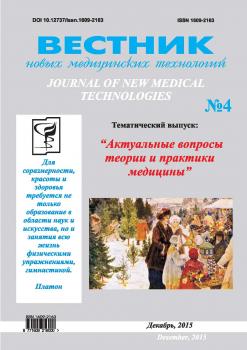The status of the processing of visual or auditory analyzer sensory reactions was examined at 146 children when moving from Orgy in Tuapse. For processing of the results was used neuromotor. It is established that the aggregate doesn’t clearly differentiate the differences between psychophysical functions before and after the latitudinal movements of the person. The substantial changes in the significance of the auditory analyzer were determined at 146 people in a pair-wise comparison by means of neuromotor. Once the authentication procedure by means of neuromotor distorts the results and its use is impractical. The increase in the number of iterations provides a predictable accuracy of the parameter identification procedure. The possibility of separating in different comparison groups, and one group (before and after exposure to these or other factors) was determined.
neuromotor, neural networks, parameter order, sensoromotor reactions.
1. Anokhin P.K. Kibernetika funktsional´nykh sis-tem. M.: Meditsina, 1998. 285 s.
2. Es´kov V.M., Es´kov V.V., Filatova O.E., Khadartsev A.A. Osobye svoystva biosistem i ikh modelirovanie. Vestnik novykh meditsinskikh tekhnologiy. 2011. T. 18. №3. S. 331-332.
3. Es´kov V.M., Burov I.V., Filatova O.E., Khadar-tsev A.A. Osnovy bioinformatsionnogo analiza dinamiki mikrokhaoticheskogo povedeniya biosistem. Vestnik novykh meditsinskikh tekhnologiy. 2012. T. 19. № 1. S. 15-18.
4. Es´kov V.M., Khadartsev A.A., Es´kov V.V., Gavrilen-ko T.V., Filatov M.A. Complexity - osobyy tip biomedi-tsinskikh i sotsial´nykh sistem. Vestnik novykh meditsin-skikh tekhnologiy. 2013. T. 20. № 1. S. 17-22.
5. Khadartsev A.A., Yashin A.A., Es´kov V.M., Agar-kov N.M., Kobrinskiy B.A., Frolov M.V., Chukhraev A.M., Gondarev S.N., Khromushin V.A., Kamenev L.I., Valenti-nov B.G., Agarkova D.I. Informatsionnye tekhnologii v meditsine. Monografiya. Tula: TulGU, 2006. 272 s.
6. Eskov V.M., Eskov V.V., Filatova O.E. Characteristic features of measurements and modeling for biosystems in phase spaces of states. Measurement Techniques (Medical and Biological Measurements). 2011. V. 53. N12. P. 1404-1410.
7. Eskov V. M., Gavrilenko T. V., Kozlova V. V., Filatov M. A.. Measurement of the dynamic parameters of microchaos in the behavior of living biosystems. Measurement Techniques. 2012. Vol. 55. № 9. P. 1096-1100.
8. Eskov V. M, Eskov V.V., Filatova O.E., Filatov M.A. Two types of systems and three types of paradigms in systems philosophy and system science. Journal of Biomedical Science and Engineering. 2012. Vol. 5. №. 10. P. 602-607.
9. Foerster´s H. Basic Concepts of Homeostasis. Homeostatic Mechanisms, Upton, New York, 1958. P. 216-242.
10. Foerster´s H. What is Memory that It May Have Hindsight and Foresight as well?. The Future of the Brain Sciences, Proceedings of a Conference held at the New York Academy of Medicine, pp. Bogoch (Hg.), Plenum Press, New York, 1969. P. 19-64.
11. Foerster´s H. Technology: What Will It Mean to Librarians?. Illinois Libraries. 1971. V. 53 (9). P. 785-803.
12. Haken H. Principles of brain functioning: a synergetic approach to brain activity, behavior and cognition (Springer series in synergetics). Springer, 1995. 349 p.
13. Mayr E.W. What evolution is Basic Books. New York, 2001. 349 p.
14. Prigogine I. The Die Is Not Cast. Futures. Bulletin of the Word Futures Studies Federation. 2000. Vol. 25. № 4. P. 17-19.





